1999 PONTIAC GRAND PRIX air condition
[x] Cancel search: air conditionPage 269 of 376
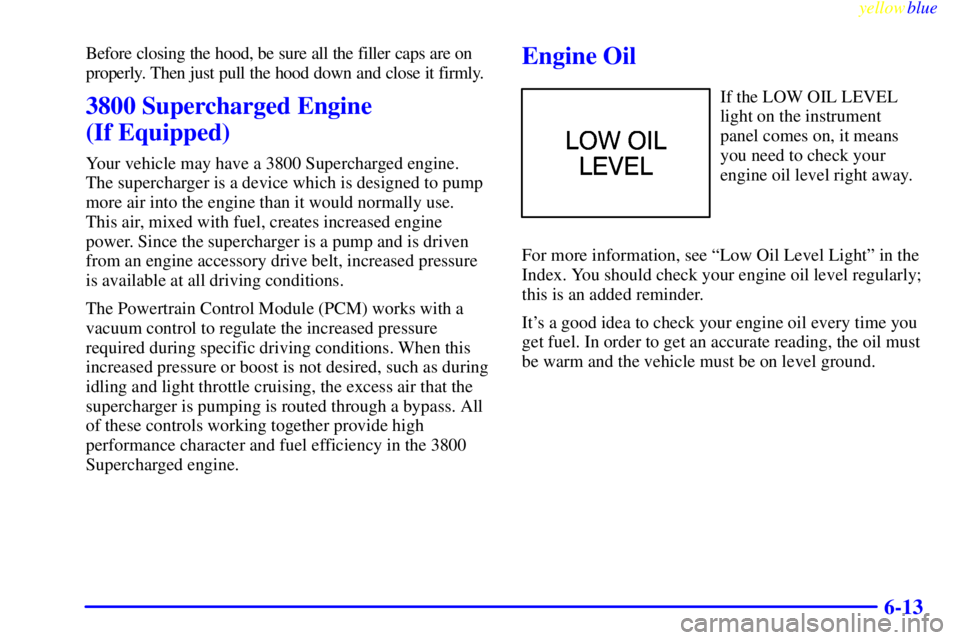
yellowblue
6-13
Before closing the hood, be sure all the filler caps are on
properly. Then just pull the hood down and close it firmly.
3800 Supercharged Engine
(If Equipped)
Your vehicle may have a 3800 Supercharged engine.
The supercharger is a device which is designed to pump
more air into the engine than it would normally use.
This air, mixed with fuel, creates increased engine
power. Since the supercharger is a pump and is driven
from an engine accessory drive belt, increased pressure
is available at all driving conditions.
The Powertrain Control Module (PCM) works with a
vacuum control to regulate the increased pressure
required during specific driving conditions. When this
increased pressure or boost is not desired, such as during
idling and light throttle cruising, the excess air that the
supercharger is pumping is routed through a bypass. All
of these controls working together provide high
performance character and fuel efficiency in the 3800
Supercharged engine.
Engine Oil
If the LOW OIL LEVEL
light on the instrument
panel comes on, it means
you need to check your
engine oil level right away.
For more information, see ªLow Oil Level Lightº in the
Index. You should check your engine oil level regularly;
this is an added reminder.
It's a good idea to check your engine oil every time you
get fuel. In order to get an accurate reading, the oil must
be warm and the vehicle must be on level ground.
Page 290 of 376

yellowblue
6-34 Brake Wear
Your vehicle has four-wheel disc brakes.
Disc brake pads have built
-in wear indicators that make a
high
-pitched warning sound when the brake pads are worn
and new pads are needed. The sound may come and go or
be heard all the time your vehicle is moving (except when
you are pushing on the brake pedal firmly).
CAUTION:
The brake wear warning sound means that soon
your brakes won't work well. That could lead to
an accident. When you hear the brake wear
warning sound, have your vehicle serviced.
NOTICE:
Continuing to drive with worn-out brake pads
could result in costly brake repair.
Some driving conditions or climates may cause a brake
squeal when the brakes are first applied or lightly
applied. This does not mean something is wrong with
your brakes.
Properly torqued wheel nuts are necessary to help
prevent brake pulsation. When tires are rotated, inspect
brake pads for wear and evenly torque wheel nuts in the
proper sequence to GM specifications.
Brake linings should always be replaced as complete
axle sets.
See ªBrake System Inspectionº in Section 7 of this manual
under Part C ªPeriodic Maintenance Inspections.º
Brake Pedal Travel
See your dealer if the brake pedal does not return to
normal height, or if there is a rapid increase in pedal
travel. This could be a sign of brake trouble.
Brake Adjustment
Every time you apply the brakes, with or without the
vehicle moving, your brakes adjust for wear.
Page 305 of 376
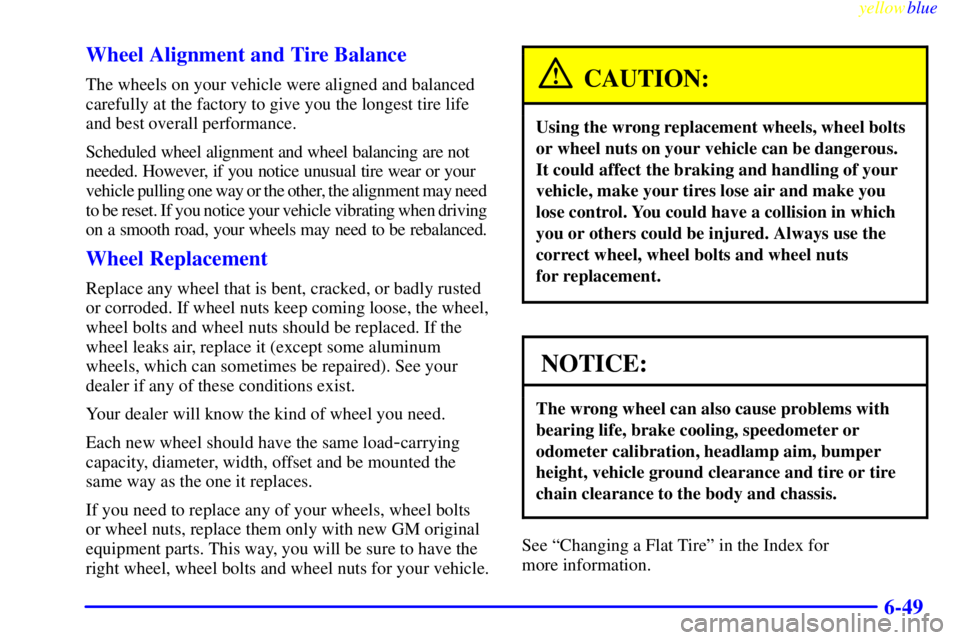
yellowblue
6-49 Wheel Alignment and Tire Balance
The wheels on your vehicle were aligned and balanced
carefully at the factory to give you the longest tire life
and best overall performance.
Scheduled wheel alignment and wheel balancing are not
needed. However, if you notice unusual tire wear or your
vehicle pulling one way or the other, the alignment may need
to be reset. If you notice your vehicle vibrating when driving
on a smooth road, your wheels may need to be rebalanced.
Wheel Replacement
Replace any wheel that is bent, cracked, or badly rusted
or corroded. If wheel nuts keep coming loose, the wheel,
wheel bolts and wheel nuts should be replaced. If the
wheel leaks air, replace it (except some aluminum
wheels, which can sometimes be repaired). See your
dealer if any of these conditions exist.
Your dealer will know the kind of wheel you need.
Each new wheel should have the same load
-carrying
capacity, diameter, width, offset and be mounted the
same way as the one it replaces.
If you need to replace any of your wheels, wheel bolts
or wheel nuts, replace them only with new GM original
equipment parts. This way, you will be sure to have the
right wheel, wheel bolts and wheel nuts for your vehicle.
CAUTION:
Using the wrong replacement wheels, wheel bolts
or wheel nuts on your vehicle can be dangerous.
It could affect the braking and handling of your
vehicle, make your tires lose air and make you
lose control. You could have a collision in which
you or others could be injured. Always use the
correct wheel, wheel bolts and wheel nuts
for replacement.
NOTICE:
The wrong wheel can also cause problems with
bearing life, brake cooling, speedometer or
odometer calibration, headlamp aim, bumper
height, vehicle ground clearance and tire or tire
chain clearance to the body and chassis.
See ªChanging a Flat Tireº in the Index for
more information.
Page 313 of 376
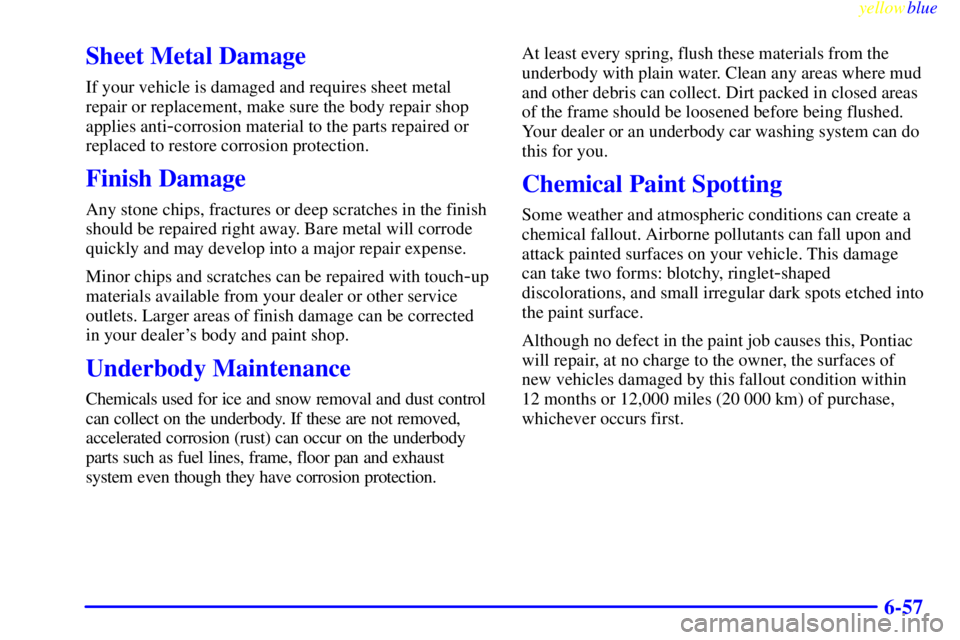
yellowblue
6-57
Sheet Metal Damage
If your vehicle is damaged and requires sheet metal
repair or replacement, make sure the body repair shop
applies anti
-corrosion material to the parts repaired or
replaced to restore corrosion protection.
Finish Damage
Any stone chips, fractures or deep scratches in the finish
should be repaired right away. Bare metal will corrode
quickly and may develop into a major repair expense.
Minor chips and scratches can be repaired with touch
-up
materials available from your dealer or other service
outlets. Larger areas of finish damage can be corrected
in your dealer's body and paint shop.
Underbody Maintenance
Chemicals used for ice and snow removal and dust control
can collect on the underbody. If these are not removed,
accelerated corrosion (rust) can occur on the underbody
parts such as fuel lines, frame, floor pan and exhaust
system even though they have corrosion protection.At least every spring, flush these materials from the
underbody with plain water. Clean any areas where mud
and other debris can collect. Dirt packed in closed areas
of the frame should be loosened before being flushed.
Your dealer or an underbody car washing system can do
this for you.
Chemical Paint Spotting
Some weather and atmospheric conditions can create a
chemical fallout. Airborne pollutants can fall upon and
attack painted surfaces on your vehicle. This damage
can take two forms: blotchy, ringlet
-shaped
discolorations, and small irregular dark spots etched into
the paint surface.
Although no defect in the paint job causes this, Pontiac
will repair, at no charge to the owner, the surfaces of
new vehicles damaged by this fallout condition within
12 months or 12,000 miles (20 000 km) of purchase,
whichever occurs first.
Page 321 of 376
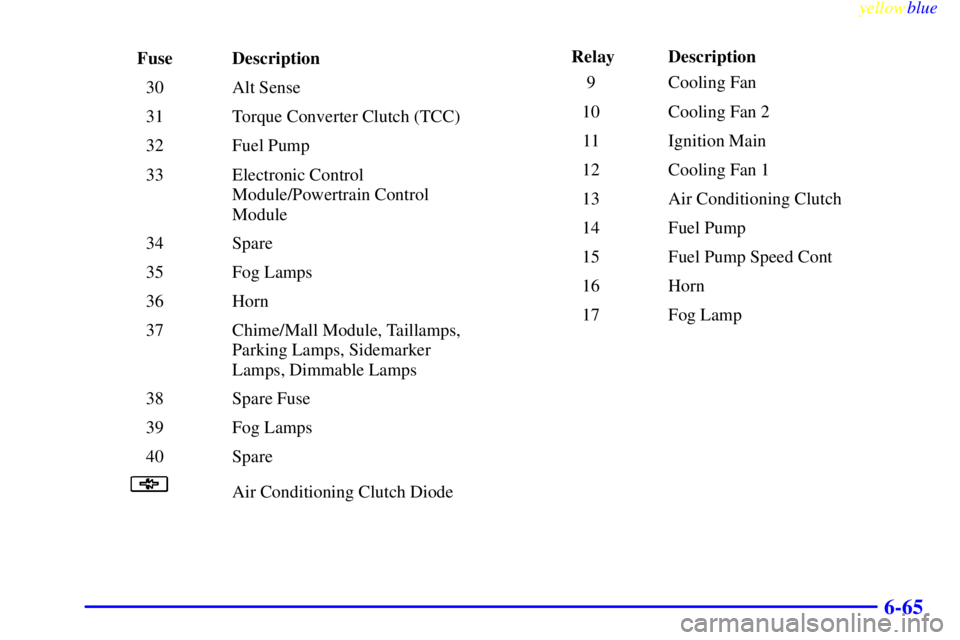
yellowblue
6-65
Fuse Description
30 Alt Sense
31 Torque Converter Clutch (TCC)
32 Fuel Pump
33 Electronic Control
Module/Powertrain Control
Module
34 Spare
35 Fog Lamps
36 Horn
37 Chime/Mall Module, Taillamps,
Parking Lamps, Sidemarker
Lamps, Dimmable Lamps
38 Spare Fuse
39 Fog Lamps
40 Spare
Air Conditioning Clutch Diode Relay Description
9 Cooling Fan
10 Cooling Fan 2
11 Ignition Main
12 Cooling Fan 1
13 Air Conditioning Clutch
14 Fuel Pump
15 Fuel Pump Speed Cont
16 Horn
17 Fog Lamp
Page 322 of 376
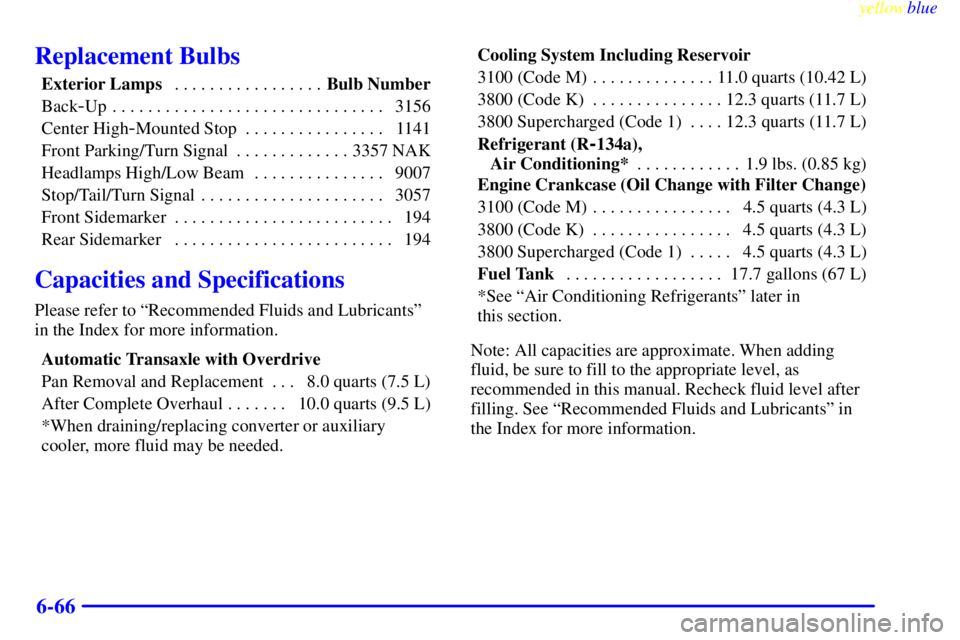
yellowblue
6-66
Replacement Bulbs
Exterior Lamps Bulb Number. . . . . . . . . . . . . . . . .
Back
-Up 3156. . . . . . . . . . . . . . . . . . . . . . . . . . . . . . .
Center High
-Mounted Stop 1141. . . . . . . . . . . . . . . .
Front Parking/Turn Signal 3357 NAK. . . . . . . . . . . . .
Headlamps High/Low Beam 9007. . . . . . . . . . . . . . .
Stop/Tail/Turn Signal 3057. . . . . . . . . . . . . . . . . . . . .
Front Sidemarker 194. . . . . . . . . . . . . . . . . . . . . . . . .
Rear Sidemarker 194. . . . . . . . . . . . . . . . . . . . . . . . .
Capacities and Specifications
Please refer to ªRecommended Fluids and Lubricantsº
in the Index for more information.
Automatic Transaxle with Overdrive
Pan Removal and Replacement 8.0 quarts (7.5 L). . .
After Complete Overhaul 10.0 quarts (9.5 L). . . . . . .
*When draining/replacing converter or auxiliary
cooler, more fluid may be needed.Cooling System Including Reservoir
3100 (Code M) 11.0 quarts (10.42 L). . . . . . . . . . . . . .
3800 (Code K) 12.3 quarts (11.7 L). . . . . . . . . . . . . . .
3800 Supercharged (Code 1) 12.3 quarts (11.7 L). . . .
Refrigerant (R
-134a),
Air Conditioning*1.9 lbs. (0.85 kg) . . . . . . . . . . . .
Engine Crankcase (Oil Change with Filter Change)
3100 (Code M) 4.5 quarts (4.3 L). . . . . . . . . . . . . . . .
3800 (Code K) 4.5 quarts (4.3 L). . . . . . . . . . . . . . . .
3800 Supercharged (Code 1) 4.5 quarts (4.3 L). . . . .
Fuel Tank17.7 gallons (67 L) . . . . . . . . . . . . . . . . . .
*See ªAir Conditioning Refrigerantsº later in
this section.
Note: All capacities are approximate. When adding
fluid, be sure to fill to the appropriate level, as
recommended in this manual. Recheck fluid level after
filling. See ªRecommended Fluids and Lubricantsº in
the Index for more information.
Page 324 of 376
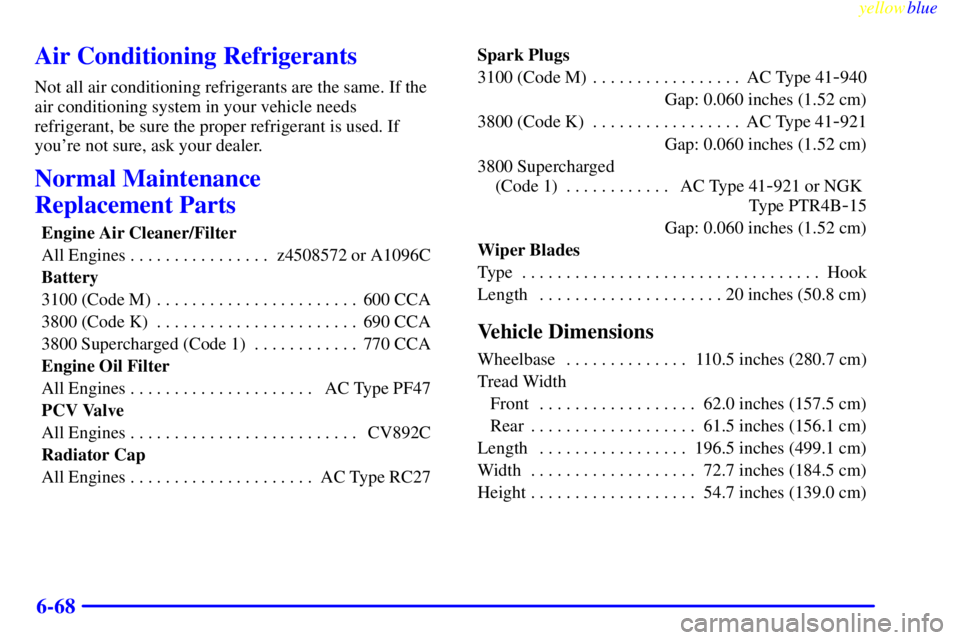
yellowblue
6-68
Air Conditioning Refrigerants
Not all air conditioning refrigerants are the same. If the
air conditioning system in your vehicle needs
refrigerant, be sure the proper refrigerant is used. If
you're not sure, ask your dealer.
Normal Maintenance
Replacement Parts
Engine Air Cleaner/Filter
All Engines z4508572 or A1096C. . . . . . . . . . . . . . . .
Battery
3100 (Code M) 600 CCA. . . . . . . . . . . . . . . . . . . . . . .
3800 (Code K) 690 CCA. . . . . . . . . . . . . . . . . . . . . . .
3800 Supercharged (Code 1) 770 CCA. . . . . . . . . . . .
Engine Oil Filter
All Engines AC Type PF47. . . . . . . . . . . . . . . . . . . . .
PCV Valve
All Engines CV892C. . . . . . . . . . . . . . . . . . . . . . . . . .
Radiator Cap
All Engines AC Type RC27. . . . . . . . . . . . . . . . . . . . . Spark Plugs
3100 (Code M) AC Type 41
-940 . . . . . . . . . . . . . . . . .
Gap: 0.060 inches (1.52 cm)
3800 (Code K) AC Type 41
-921 . . . . . . . . . . . . . . . . .
Gap: 0.060 inches (1.52 cm)
3800 Supercharged
(Code 1) AC Type 41
-921 or NGK . . . . . . . . . . . .
Type PTR4B
-15
Gap: 0.060 inches (1.52 cm)
Wiper Blades
Type Hook. . . . . . . . . . . . . . . . . . . . . . . . . . . . . . . . . .
Length 20 inches (50.8 cm). . . . . . . . . . . . . . . . . . . . .
Vehicle Dimensions
Wheelbase 110.5 inches (280.7 cm). . . . . . . . . . . . . .
Tread Width
Front 62.0 inches (157.5 cm). . . . . . . . . . . . . . . . . .
Rear 61.5 inches (156.1 cm). . . . . . . . . . . . . . . . . . .
Length 196.5 inches (499.1 cm). . . . . . . . . . . . . . . . .
Width 72.7 inches (184.5 cm). . . . . . . . . . . . . . . . . . .
Height 54.7 inches (139.0 cm). . . . . . . . . . . . . . . . . . .
Page 326 of 376
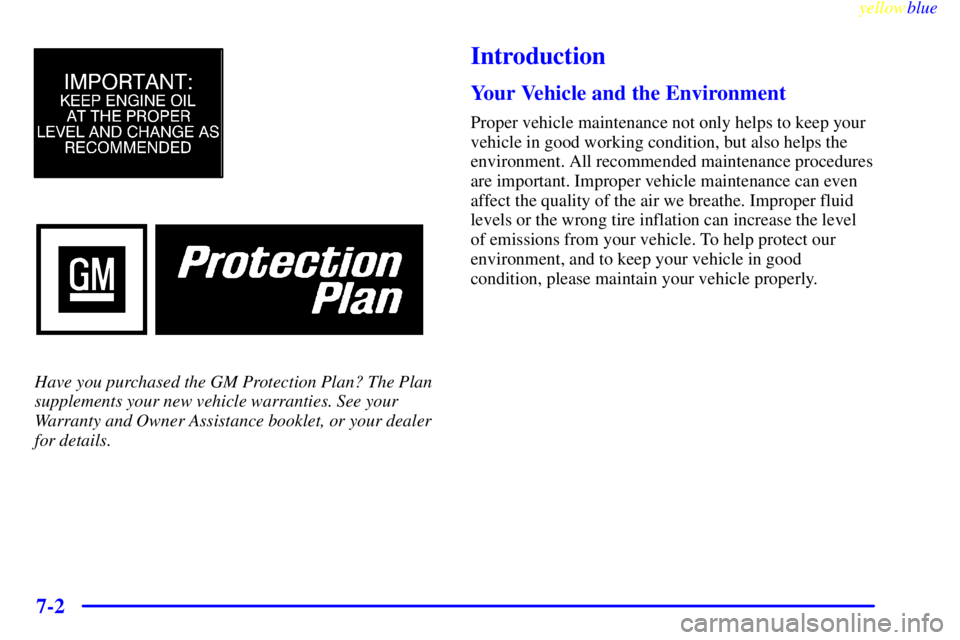
yellowblue
7-2
Have you purchased the GM Protection Plan? The Plan
supplements your new vehicle warranties. See your
Warranty and Owner Assistance booklet, or your dealer
for details.
Introduction
Your Vehicle and the Environment
Proper vehicle maintenance not only helps to keep your
vehicle in good working condition, but also helps the
environment. All recommended maintenance procedures
are important. Improper vehicle maintenance can even
affect the quality of the air we breathe. Improper fluid
levels or the wrong tire inflation can increase the level
of emissions from your vehicle. To help protect our
environment, and to keep your vehicle in good
condition, please maintain your vehicle properly.